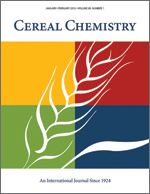
Cereal Chem 61:112 - 116. | VIEW
ARTICLE
Do-Corder Studies on Dough Development. I. Interactions of Water Absorption, Sulfhydryl Level, and Free Lipid Content in Heated Dough.
S. Endo, K. Tanaka, and S. Nagao. Copyright 1984 by the American Association of Cereal Chemists, Inc.
A Brabender Do-Corder was used to study factors affecting the rheological properties of doughs in terms of dough development. The major peak of the Do-Corder curve for a dough, developed in another mixing apparatus before heat treatment, shifted from 85 to 75 C, compared with that for a control flour. The shift was influenced by mixing time and absorption level. The shift in this peak was promoted by an increase in the water absorption level. There was a rapid decrease in the content of sulfhydryl and free lipid extracted with ethyl ether at an early stage of mixing. However, the decrease in sulfhydryl content for a control flour after heat treatment in the Do-Corder was small compared with that for a premixed dough. Free lipid in a premixed dough incrased greatly as a rsult of heat treatment in the Do-Corder, despite a slight decrease in free lipid observed in a control flour after heating. Flour protein was responsible for the rheological changes of doughs during prolonged mixing, judging from the changes in sulfhydryl content and lipid binding. On the other hand, little response was shown in Do-Corder curves for doughs containing N-ethylmaleimide.